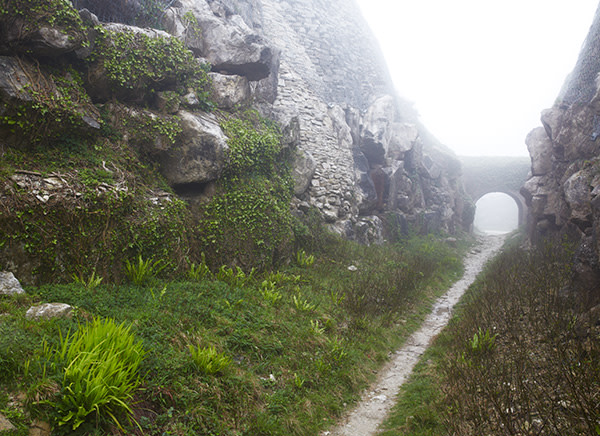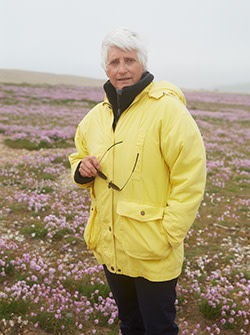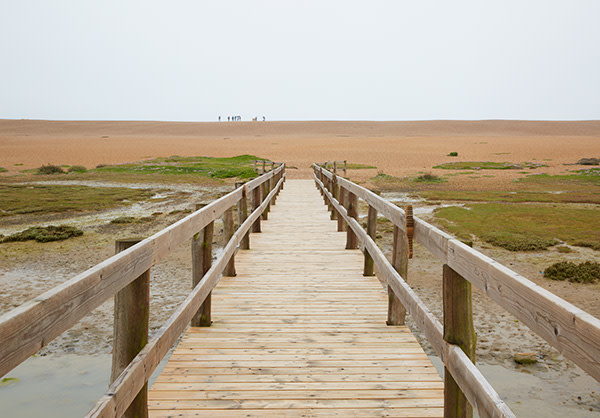The Isle of Portland route with Sue Clifford

Simply sign up to the Life & Arts myFT Digest -- delivered directly to your inbox.
Before we head to the Isle of Portland, that strange little peninsula that hangs off the coast of Dorset like a tail, Sue Clifford emails me some mysterious clues. “Alleys, beachcombing, field patterns, kerbstones,” she suggests. “Ammonites, cliffs, fog and mist, lagoons, lighthouses, shingle, unlucky words.”
On Foot and Coasting, the books she has co-authored with Angela King, are no ordinary guidebooks; rather, they are alphabetical lists that concentrate on the quirks and local distinctiveness of the English countryside. On Foot starts with “Alleys” and finishes with “Zigzags”; Coasting begins at “Albion” and ends at “Zawns”.
In between, each book covers a medley of fascinating, charming and/or downright strange features. “The books don’t attempt to lead people around a place but help them to savour the detail and compare the differences with where or what they know,” explains Clifford. “Not so much ‘turn right at so-and-so’, rather ‘ooh, why is that there and why is it so different?’”
It turns out that reading “Fog & Mist”, an entry that mentions the “low moans of the diaphone foghorn on the lighthouse at Portland Bill”, was prescient. When we meet at the visitor centre on the causeway that links Portland to the mainland, the summit of the island is wreathed in grey.
The first part of our route follows Chesil Beach, the great bank of shingle that stretches from West Bay to Chiswell village on Portland, where we are heading. The shifting stones underfoot make for hard walking but it’s the place to look for seabirds – Portland is home to one of the country’s largest colonies of little terns, among many other species – and the characteristic yellow horned poppies that replace late spring’s sea-thrift carpet of “Portland Pinks”.
“The poppies somehow hang on in the pebbles,” says Clifford. “It’s a very austere landscape, hard lines everywhere, then the foreground suddenly moves and you realise you’re glancing at a host of little birds foraging.”
Portland’s austere appeal is a distinct contrast to that of Dorset’s typical green hills and pretty villages. The island has a harder edge. It bears the physical scars of its long history of stone quarrying, has served as a military base, is home to a prison and a young offenders’ institution and, although it’s linked to the mainland, seems distinctly separate from it. “Portland stands apart, partly because it’s an island, which is always magical, but it also seems a very introspective place,” says Clifford.
As we come into Chiswell, she points out a series of opes: narrow passages between the houses that open towards the sea and allow the water to drain freely if it encroaches on the land. The term ope is particular to Chiswell – and is a perfect example of the regional peculiarities that Clifford’s books point up (elsewhere in Dorset we might be looking for drongs, while Sussex has twittens and Northumberland has chares).

Chiswell’s high doorsteps and kerbstones are also signs that the sea sometimes makes unwelcome incursions, says Clifford. The guttering along the road is made of Portland stone, readily available here for any purpose but a prestigious building material elsewhere, hauled up country to construct St Paul’s Cathedral, Buckingham Palace, the Cenotaph …
The name of one of the opes – Lerret Ope – refers to another Portland speciality: lerrets, long since disappeared, were double-ended boats that could be nimbly landed either front or backwards on Chesil’s great bank of stones. The sea here is “extraordinarily powerful”, says Clifford, and you wouldn’t have wanted to try turning your small craft as the waves bore you towards the unforgiving shingle – particularly if you were landing smuggled goods in the dark.
The coast path takes a short, steep clamber up above Chiswell. By now, the mist is lifting; from the top of the cliff there is a fine view of Chesil’s 18-mile length and the Fleet Lagoon behind it. Although sea defences built in the 1980s saved Portland from a far more severe battering in last winter’s storms, there have been several landslips along the coast path, but the detours are well signed and one leads through Tout Quarry, now a sculpture park. A stone squid looms surprisingly.
While the short clifftop turf is rabbit-friendly terrain, we don’t see a single one – which is perhaps just as well. The r-word is considered so unlucky that it is never used by Portland locals, who refer instead to “coneys” or “burrowing mutton”. “It’s possible that seeing rabbits running meant a rockfall in the quarry was going to happen – but we found the same phenomenon in Northumberland and the Scottish islands, and my own theory is that the reference is actually to hares, which have so much folklore associated with them,” says Clifford. “It’s something that goes very deep – in some areas if you saw a hare you wouldn’t go fishing that day.”

The route turns inland behind the houses of Weston and cuts directly across the island to pick up the coast path on its eastern side, passing through Perryfield Quarry, where there is a large and perfect ammonite in one of the blocks of stone waiting to be hauled away. The path climbs steeply up the cliff to emerge alongside the young offenders’ institution, an unlovely sight to hurry past until paved road again gives way to footpath. As we pass through King Barrow Quarries, the rain has set in. Luckily the path is less windswept as it descends into Fortuneswell and the pavement is a flatter alternative to braving Chesil’s shingle for a second time on the return to the visitors’ centre.
Over a Portland crab sandwich in the café, Clifford shows me England in Particular, the volume from which On Foot and Coasting have been extracted. Researched over 20 years, it is an entrancing book, every dip into it yielding a surprise. “It’s about getting people to notice what they take for granted, to see it with fresh eyes,” says Clifford. “Even different weather in a familiar place can make you suddenly alert.” She’s right: as we leave, the sun has come out, the sky has turned blue and, as she observes, the Isle of Portland suddenly looks like Table Mountain.
‘Coasting’ and ‘On Foot’ by Sue Clifford and Angela King are published by Saltyard Books, £12.99 each
Photographs: Robin Friend
Comments